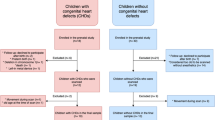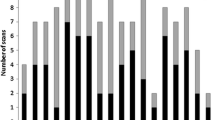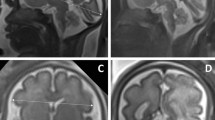Abstract
Objective
This study employed magnetic resonance imaging (MRI) to compare brain volumes of discordant twins and examined their neurodevelopment after birth by using a validated exam.
Study design
A prospective historical cohort study of discordant dichorionic diamniotic (DCDA) or monochorionic diamniotic (MCDA) twin fetuses, who undergone an MRI scan to evaluate growth restriction in the discordant twin (weight < 10th centile) during 6 years period, at a single tertiary center. Twenty-seven twin pairs were included in the volumetric study and 17 pairs were included in the neurodevelopmental outcome examination. The volumes of the supratentorial brain region, both hemispheres, eyes, and the cerebellum were measured by 3D MRI semi-automated volume measurements. Volumes were plotted on normal growth curves and discordance was compared between weight at birth and brain structure volumes. Neurodevelopmental outcome was evaluated using the VABS-II questionnaire at a mean age of 4.9 years.
Results
The volume of major brain structures was significantly larger in the appropriate-for-gestational-age twins (AGA) compared to the small-for-gestational-age (SGA) co-twins (p < 0.001). The birth weight discordance was 32.3% (24.9–48.6) and was significantly greater (p < 0.001) than the discordance of the prenatal supratentorial brain (13.6% [5.6–18]), cerebellum volume (21.7% [9.5–30.8]). Further neurodevelopmental outcome evaluation found no significant difference between the AGA twin and the SGA twin.
Conclusion
In discordant twins, the smaller twin showed a “brain-preserving effect,” which in our study was not associated with a worse neurodevelopmental outcome. The use of MRI in such cases may aid in decision-making and parental consultation.
Key Points
• Weight discordance at birth was significantly greater compared to intrauterine brain volume discordance measured by 3D MRI.
• Small-for-gestational-age (SGA) fetuses preserve brain development.
• In highly discordant twins, there was no long-term difference in neurodevelopmental outcome at a mean age of 4.9 years.




Similar content being viewed by others
Abbreviations
- AEDF:
-
Absent end-diastolic flow
- AGA:
-
Appropriate for gestational age
- CGH:
-
Comparative genomic hybridization
- CV:
-
Cerebellum volume
- DCDA:
-
Dichorionic diamniotic
- FGR:
-
Fetal growth restriction
- HC:
-
Head circumference
- IUGR:
-
Intrauterine growth restriction
- LEBV:
-
Left eyeball volume
- LHV:
-
Left hemisphere volume
- MCDA:
-
Monochorionic diamniotic
- MRI :
-
Magnetic resonance imaging
- REBV:
-
Right eyeball volume
- REDF:
-
Reversed end-diastolic flow
- RHV:
-
Right hemisphere volume
- SGA:
-
Small for gestational age
- STV:
-
Supratentorial volume
- US:
-
Ultrasonography
- VABS:
-
Vineland Adaptive Behavior Scales
References
Kulkarni AD, Jamieson DJ, Jones HW et al (2013) Fertility treatments and multiple births in the united states. N Engl J Med 369:2218–2225
Bagchi S, Salihu HM (2006) Birth weight discordance in multiple gestations: Occurrence and outcomes. J Obstet Gynaecol 26:291–296
Muhlhausler BS, Hancock SN, Bloomfield FH, Harding R (2011) Are twins growth restricted? Pediatr Res 70:117–122
Baschat AA (2014) Neurodevelopment after fetal growth restriction. Fetal Diagn Ther 36:136–142
Geva R, Eshel R, Leitner Y, Fattal-Valevski A, Harel S (2006) Memory functions of children born with asymmetric intrauterine growth restriction. Brain Res 1117:186–194
Geva R, Eshel R, Leitner Y, Fattal-Valevski A, Harel S (2006) Neuropsychological outcome of children with intrauterine growth restriction: a 9-year prospective study. Pediatrics 118:91–100
Tolsa CB, Zimine S, Warfield SK et al (2004) Early alteration of structural and functional brain development in premature infants born with intrauterine growth restriction. Pediatr Res 56:132–138
Yinon Y, Mazkereth R, Rosentzweig N, Jarus-Hakak A, Schiff E, Simchen MJ (2005) Growth restriction as a determinant of outcome in preterm discordant twins. Obstet Gynecol 105:80–84
Hartley RS, Hitti J, Emanuel I (2002) Size-discordant twin pairs have higher perinatal mortality rates than nondiscordant pairs. Am J Obstet Gynecol 187:1173–1178
Blickstein I, Keith LG (2004) Neonatal mortality rates among growth-discordant twins, classified according to the birth weight of the smaller twin. Am J Obstet Gynecol 190:170–174
Vedel C, Oldenburg A, Worda K et al (2017) Short- and long-term perinatal outcome in twin pregnancies affected by weight discordance. Acta Obstet Gynecol Scand 96:233–242
Breathnach FM, McAuliffe FM, Geary M et al (2011) Definition of intertwin birth weight discordance. Obstet Gynecol 118:94–103
Harper LM, Weis MA, Odibo AO, Roehl KA, Macones GA, Cahill AG (2013) Significance of growth discordance in appropriately grown twins. Am J Obstet Gynecol 208:393.e1–393.e5
Victoria A, Mora G, Arias F (2001) Perinatal outcome, placental pathology, and severity of discordance in monochorionic and dichorionic twins. Obstet Gynecol 97:310–315
Garite TJ, Clark RH, Elliott JP, Thorp JA (2004) Twins and triplets: The effect of plurality and growth on neonatal outcome compared with singleton infants. Am J Obstet Gynecol 191:700–707
Ross GS, Krauss AN, Perlman JM (2012) Physical growth and cognitive abilities in concordant versus discordant birth weight twins at three years old. Early Hum Dev 88:753–756
Swamy RS, McConachie H, Ng J et al (2018) Cognitive outcome in childhood of birth weight discordant monochorionic twins: the long-term effects of fetal growth restriction. Arch Dis Child Fetal Neonatal Ed 103:F512–F516
Adegbite AL, Castille S, Ward S, Bajoria R (2004) Neuromorbidity in preterm twins in relation to chorionicity and discordant birth weight. Am J Obstet Gynecol 190:156–163
Glenn OA (2010) MR imaging of the fetal brain. Pediatr Radiol 40:68–81
Hadlock FP, Harrist RB, Carpenter RJ, Deter RL, Park SK (1984) Sonographic estimation of fetal weight. The value of femur length in addition to head and abdomen measurements. Radiology 150:535–540
Dollberg S, Haklai Z, Mimouni FB et al (2005) Birth weight standards in the live-born population in Israel. Isr Med Assoc J 7:311–314
Ber R, Hoffman D, Hoffman C et al (2017) Volume of structures in the fetal brain measured with a new semiautomated method. AJNR Am J Neuroradiol 38:2193–2198
Pugliese CE, Anthony L, Strang JF, Dudley K, Wallace GL, Kenworthy L (2015) Increasing adaptive behavior skill deficits from childhood to adolescence in autism spectrum disorder: Role of executive function. J Autism Dev Disord 45:1579–1587
Moler FW, Silverstein FS, Dean JM (2017) Hypothermia after in-hospital cardiac arrest in children. N Engl J Med 376:1695–1697
Sparrow SS, Cicchetti DV (1985) Diagnostic uses of the Vineland Adaptive Behavior Scales. J Pediatr Psychol 10:215–225
Sparrow SS (2011) Vineland Adaptive Behavior Scales. In: Encyclopedia of Clinical Neuropsychology. Springer, New York
Bar-Yosef O, Barzilay E, Dorembus S, Achiron R, Katorza E (2017) Neurodevelopmental outcome of isolated ventriculomegaly: a prospective cohort study. Prenat Diagn 37:764–768
Rigby RA, Stasinopoulos DM (2014) Automatic smoothing parameter selection in GAMLSS with an application to centile estimation. Stat Methods Med Res 23:318–332
Borghi E, de Onis M, Garza C et al (2006) Construction of the world health organization child growth standards: selection of methods for attained growth curves. Stat Med 25:247–265
Polat A, Barlow S, Ber R, Achiron R, Katorza E (2017) Volumetric MRI study of the intrauterine growth restriction fetal brain. Eur Radiol 27:2110–2118
Groene SG, Tollenaar LSA, Oepkes D, Lopriore E, van Klink JMM (2019) The impact of selective fetal growth restriction or birth weight discordance on long-term neurodevelopment in monochorionic twins: a systematic literature review. J Clin Med 8:944
Andescavage N, DuPlessis A, Metzler M et al (2017) In vivo assessment of placental and brain volumes in growth-restricted fetuses with and without fetal Doppler changes using quantitative 3D MRI. J Perinatol 37:1278–1284
Caetano ACR, Zamarian ACP, Araujo E et al (2015) Assessment of intracranial structure volumes in fetuses with growth restriction by 3-dimensional sonography using the extended imaging virtual organ computer-aided analysis method. J Ultrasound Med 34:1397–1405
Benavides-Serralde A, Hernández-Andrade E, Fernández-Delgado J et al (2009) Three-dimensional sonographic calculation of the volume of intracranial structures in growth-restricted and appropriate-for-gestational age fetuses. Ultrasound Obstet Gynecol 33:530–537
Funding
The authors state that this work has not received any funding.
Author information
Authors and Affiliations
Corresponding author
Ethics declarations
Guarantor
The scientific guarantor of this publication is Prof. Eldad Katorza MD, MSC, MBA.
Conflict of interest
The authors of this manuscript declare no relationships with any companies whose products or services may be related to the subject matter of the article.
Statistics and biometry
Tomer Ziv Baran, PhD, kindly provided statistical advice for this manuscript.
Informed consent
Written informed consent was waived by the institutional review board.
Ethical approval
Institutional Review Board approval was obtained: 0256-13-SMC.
Methodology
• Prospective historical cohort
• Diagnostic or prognostic study
• Performed at one institution
Additional information
Publisher’s note
Springer Nature remains neutral with regard to jurisdictional claims in published maps and institutional affiliations.
Rights and permissions
About this article
Cite this article
Halevy, T., Nezer, M., Halevy, J. et al. Twin discordance: a study of volumetric fetal brain MRI and neurodevelopmental outcome. Eur Radiol 31, 6676–6685 (2021). https://doi.org/10.1007/s00330-021-07773-5
Received:
Revised:
Accepted:
Published:
Issue Date:
DOI: https://doi.org/10.1007/s00330-021-07773-5




